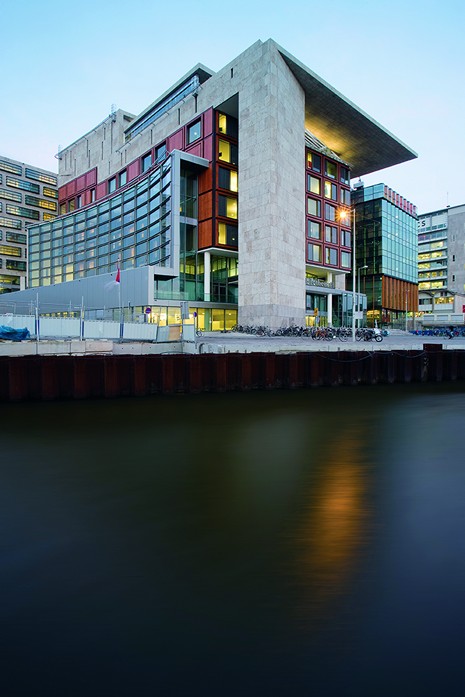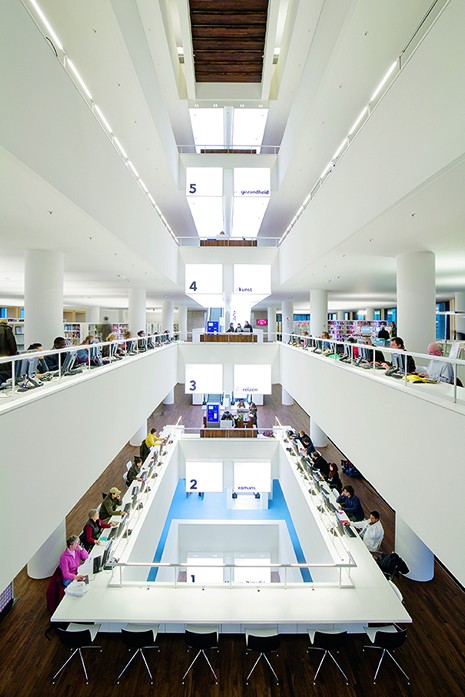Description
Completed in 2007, the Amsterdam Central Library or OBA – Openbare Bibliotheek Amsterdam, is currently the largest library in the Netherlands with 1.5 million books and 13 floors occupying 28,000 m². A replacement for the 1919 Prinsengracht library, a facility half the size, the OBA not only provides state-of-the-art library service but also public access to a theater, multi-media space, two cafés, and a restaurant. The OBA is situated on Oosterdokseiland, a new 200,000 m², mixed-use development planned to transform the IJ River bank into a dynamic work/live neighborhood. The master plan for restructuring this land adjacent to the Central Station, also includes office space, a four-star hotel, a convention center, a variety of shops, restaurants, bars and a music academy. Architect Jo Coenen took advantage of this opportunity to incorporate aspects of urban life into the modern public library.
As the first project of Oosterdokseiland to be constructed, Coenen, known for his emphasis on contextualization, looked to design from inside out. The spatial sequence, derived from a unique view of the library program, is divided into three categories; “speed/haste”, “rest” and “meet/relax/interact” – classifications that expand typical library functions and serve to attract a broader segment of users.
The classification of “speed/haste” refers to the entry levels and includes library programs such as the children’s library, exhibition, periodicals, a panini bar/café and a multi-media space, all of which serve as a transition from the public urban space to the book stacks above. Designed for citizens of all ages from the young to the old, the entry levels act as a general living room for the city and offer a pause in the rhythm of urban life.
The classification of “rest” refers to the stacks that occupy five floors in the distinct and physically separated middle volume. These are spaces specifically designed to house the function of study and reading. The five floors utilize an architectural palette of black, white and wood and are centered around an atrium circumscribed by study desks built into the guardrails. White sculptural forms of molded plastic serve as iconic info points throughout the stacks. Plastic seating pods in different shapes serve as furniture.
The library’s architecture helps visitors to orientate themselves. The escalators in the heart of the building, which also function as a light object, the large open space next to them, the connections of the different floors provided by the voids and the many different views to the outside, all serve to help visitors find their way around the library. “Meet/relax/interact” refers to the top levels, which house a theater, bar, restaurant and a roof terrace with a panoramic view of Amsterdam. As an additional program that augments traditional library service, these functions are placed strategically at the top and draw the user through the many levels of study and book stacks dedicated to reading.
These three classifications are also used to divide the massing of the building into plinth, middle and top, in order to conform to building guidelines prescribed for the entire development. The entry levels or “plinth” align with required setbacks while the floors above are an intricate play of volumes that protrude and recede beneath an enormous stone canopy, 13 stories up in the air. This approach to meeting setbacks and building heights is accompanied by a use of glass that gives consideration to the availability of natural light for future, neighboring buildings. At an urban level, this massing recalls that of the temples of Antiquity and evokes a monumental scale that designates the entry plaza as a grand, civic meeting place. The upside-down L of natural stone at the front side of the building is an element that is clearly discernible from afar and the library has thus also become a visual landmark for Oosterdokseiland.
The success of OBA as a modern, public library is derived, in part, from its inclusion within the Oosterdokseiland development. Mirroring the goals of the development to create a unique urban live/work environment in the old harbor, similar strategies are utilized in the library to reinvent and redefine the role of the public library as a type. At a time when the role of books in 21st century life has been questioned, architect Jo Coenen embraces aspects of modern, urban life and incorporates them as library program. In doing so, he affirms the role of the public library as an active center of the modern city.
Drawings
Ground floor
Third floor
Cross section
Longitudinal section
Photos

View of the OBA on Oosterdokseiland

View of counter seating wraps the edges of the multi-level atrium
Originally published in: Nolan Lushington, Wolfgang Rudorf, Liliane Wong, Libraries: A Design Manual, Birkhäuser, 2016.